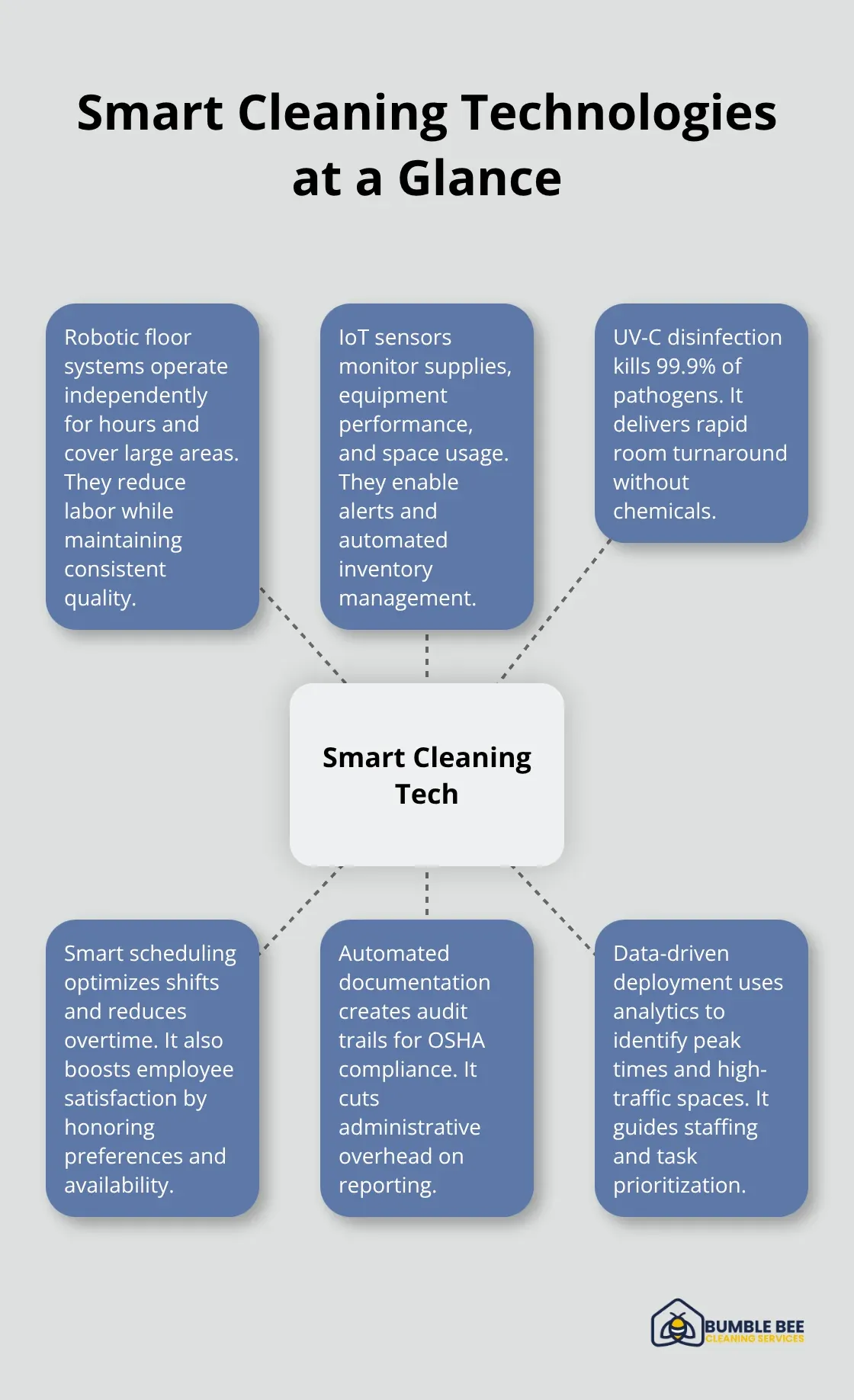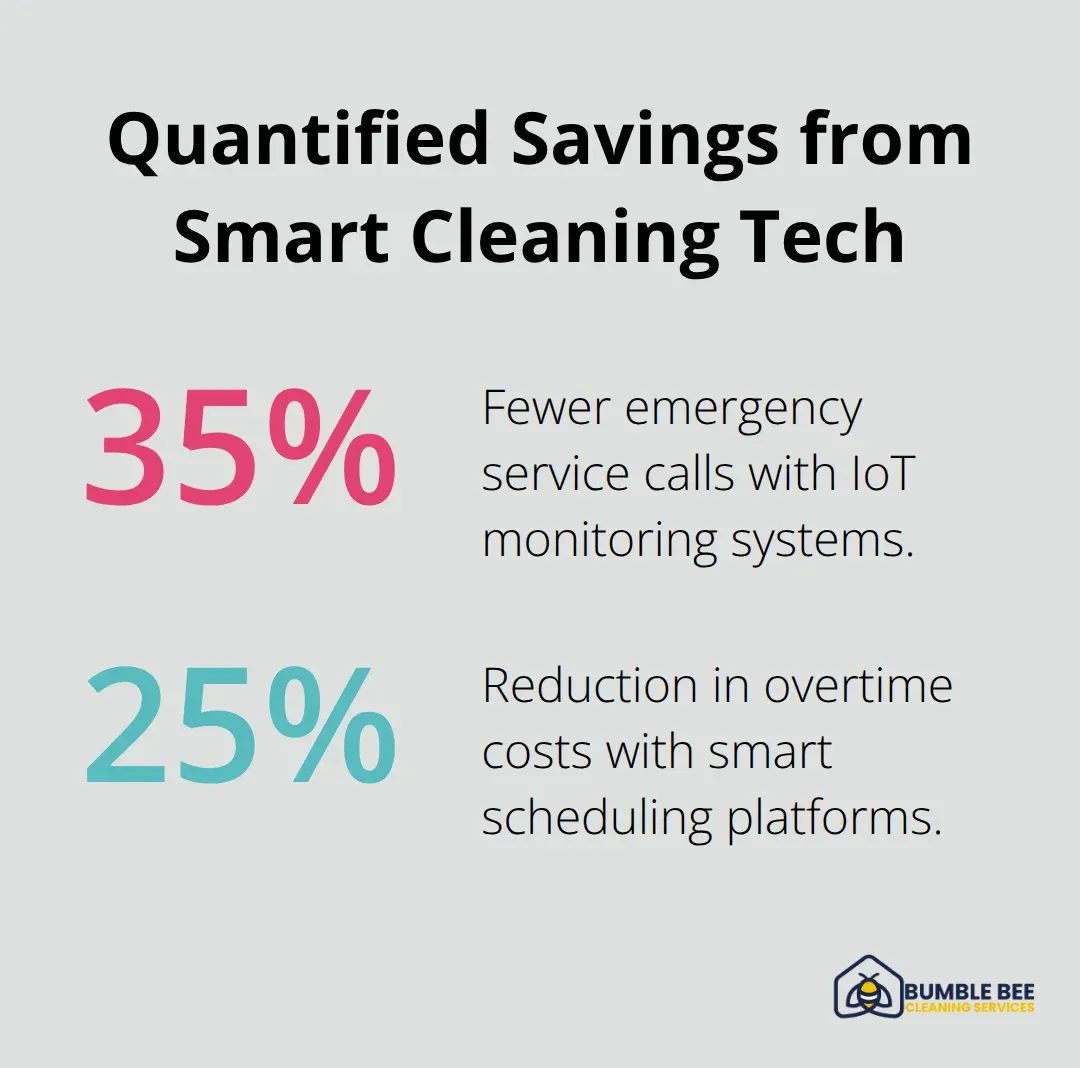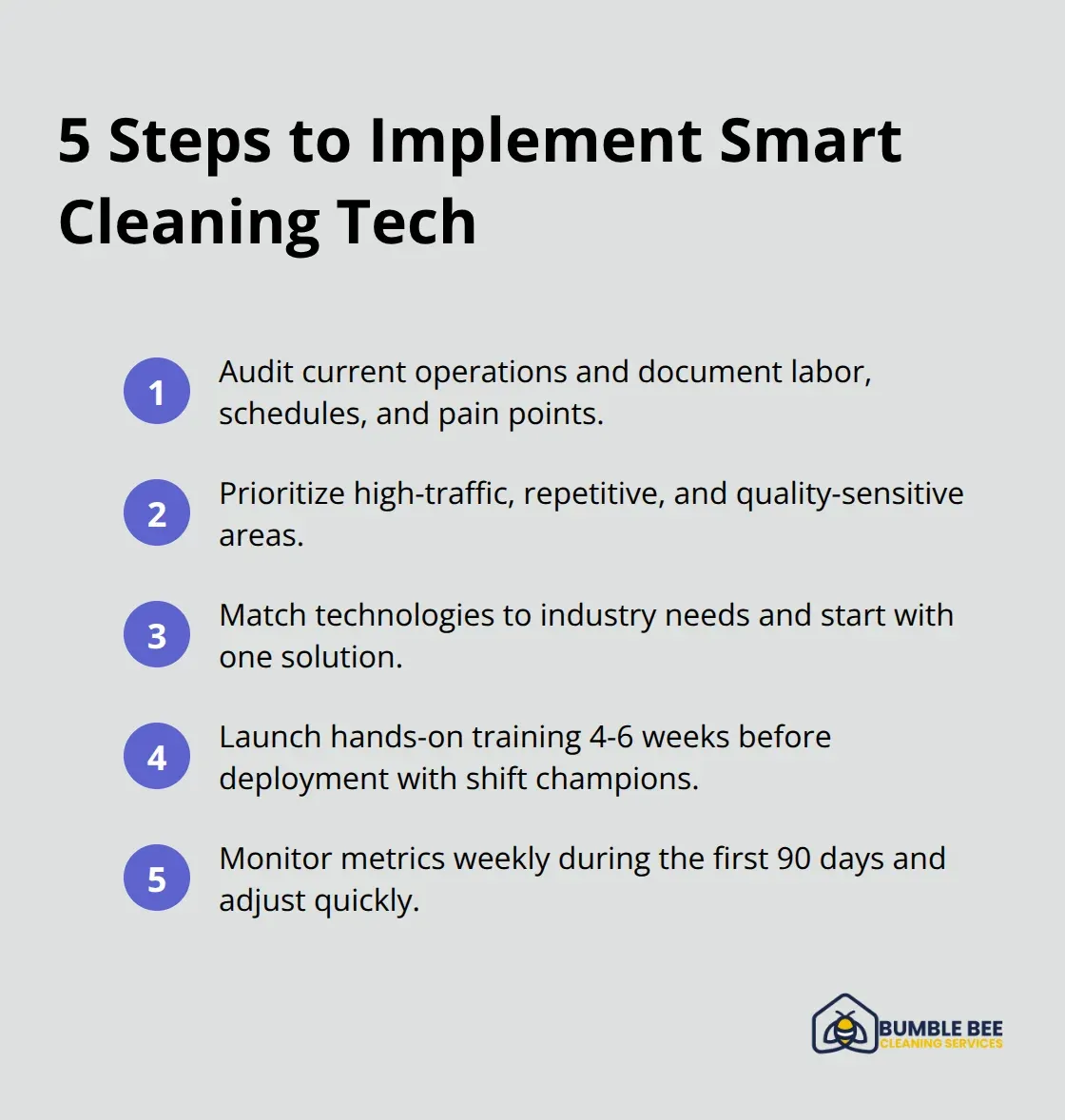Seattle businesses are rapidly adopting janitorial technology to streamline operations and reduce costs. Smart cleaning solutions now deliver measurable results across industries, from automated floor systems to IoT monitoring.
We at Bumble Bee Cleaning Services see companies cutting labor expenses by 30% while improving cleanliness standards. The right technology transforms your cleaning operations into a competitive advantage.
Smart Cleaning Technologies That Transform Seattle Businesses
Robotic Floor Systems That Pay for Themselves
Automated floor systems revolutionize your maintenance schedule. Commercial robotic cleaners like the Tennant T7AMR operate independently for up to 5 hours and cover 25,000 square feet per charge. These machines reduce labor costs while they maintain consistent quality standards.
The cleaning robot market is projected to reach USD 21.01 billion by 2030, growing at a CAGR of 23.7%. The technology performs best in open floor plans like warehouses, retail spaces, and office lobbies where obstacles stay minimal. Your staff can focus on detail work while robotic floor scrubbers handle the repetitive tasks.

IoT Sensors Track Everything in Real-Time
Smart sensors monitor supply levels, equipment performance, and space usage patterns continuously. IoT-enabled devices enable intelligent waste management systems through automated inventory management. Sensors track restroom traffic and send alerts when usage thresholds trigger the need for attention.
Seattle companies report fewer maintenance emergencies and better resource allocation with IoT management systems. The data shows you exactly when to staff peak hours instead of relying on guesswork (no more overstaffing during slow periods).
UV-C Technology Eliminates 99.9% of Pathogens
Advanced UV-C light kills bacteria, viruses, and mold without chemicals. UV-C robots like those from Xenex complete room disinfection in 5-10 minutes, compared to 30 minutes for manual chemical methods. Healthcare facilities achieve significant infection rate reductions with UV-C implementation according to Johns Hopkins studies.
The technology excels in high-traffic areas like conference rooms, break rooms, and medical offices where traditional methods fall short. Your team can disinfect multiple rooms quickly while maintaining superior pathogen elimination rates.
Smart Scheduling Optimizes Your Workforce
AI-powered scheduling platforms reduce labor costs through optimized workforce allocation. These systems consider worker preferences and availability, which leads to better work-life balance and higher employee satisfaction. Real-time adaptability allows quick accommodation of last-minute changes and absences.
Smart scheduling provides data analytics that track efficiency and client satisfaction. Mobile accessibility lets managers and employees handle schedules remotely, which proves essential for field operations. Now you can evaluate how these technologies fit your specific operational needs and budget requirements.
Does Smart Cleaning Tech Actually Save Money
Smart cleaning technology requires significant upfront investment, but the numbers show compelling returns within 18 months for most Seattle businesses. A robotic floor cleaner requires substantial initial investment, yet saves $2,000-$4,000 monthly in labor expenses according to data from the International Sanitary Supply Association. Companies typically break even within 12-15 months while they gain superior cleaning consistency.
Labor Cost Reductions Drive Real Savings
Automated systems slash staffing requirements by 40-60% for routine maintenance tasks. One robotic unit replaces 2-3 cleaning staff members during overnight shifts, which generates annual savings of $80,000-$120,000 in wages and benefits. IoT monitoring systems reduce emergency service calls by 35% through predictive maintenance alerts.

UV-C disinfection cuts manual sanitization time from 30 minutes to 5 minutes per room. This allows teams to service 3x more locations daily. Smart scheduling platforms optimize workforce allocation and reduce overtime costs by 25% through better shift planning.
Health Compliance Prevents Costly Violations
Enhanced disinfection standards protect against regulatory fines and liability issues. Healthcare facilities that use UV-C technology maintain improved infection control standards, though specific reduction rates vary by facility type and implementation. Commercial properties maintain higher air quality standards, which reduces sick leave claims and workers’ compensation costs.
Automated cleaning documentation provides audit trails that satisfy OSHA requirements without additional administrative overhead. These systems eliminate the guesswork from compliance reporting.
Technology Integration Requires Strategic Planning
The transition to smart cleaning technology demands careful evaluation of your current operations and specific industry needs. Different sectors benefit from different technological approaches, and the implementation strategy determines your success rate. Recurring services provide the deepest discounts since consistent appointments reduce setup time and travel costs for cleaning teams.
How Do You Successfully Implement Smart Cleaning Technology
Start with a comprehensive audit of your current operations to identify exactly where technology can deliver the highest returns. Document your existing labor costs, schedules, and problem areas where manual processes consistently fail or require excessive time. Seattle businesses that skip this analysis waste significant portions of their technology investment on solutions that don’t address their primary operational challenges.

Focus on spaces with high foot traffic, repetitive tasks, and areas where consistent quality proves difficult to maintain. Retail spaces benefit most from robotic floor systems, while healthcare facilities see maximum value from UV-C technology.
Match Technology to Your Industry Requirements
Different industries require specific technological approaches for optimal results. Office buildings with large open floor plans can achieve substantial labor cost reductions through robotic floor cleaners, while medical facilities need UV-C systems for pathogen elimination.
Restaurants and food service operations benefit most from IoT sensors that monitor kitchen cleanliness and automate supply orders. Manufacturing facilities require heavy-duty automated systems that handle industrial debris and chemical residues. Start with one technology that addresses your biggest pain point rather than implement multiple systems simultaneously.
Execute Training Programs That Actually Work
Staff resistance affects many technology implementations with trust and safety being top concerns. Begin training programs 4-6 weeks before technology deployment to build familiarity and reduce anxiety. Create hands-on practice sessions where employees operate the new equipment in low-pressure environments.
Designate technology champions within each shift who can troubleshoot minor issues and mentor other team members. Companies that invest in comprehensive training see higher profit margins compared to those with minimal preparation (this demonstrates the clear ROI of proper staff development).
Monitor Performance During the First 90 Days
Schedule regular check-ins during the first three months to address concerns and optimize workflows based on real-world usage patterns. Track key metrics like time savings, quality improvements, and staff satisfaction scores weekly rather than monthly. This frequent monitoring allows you to make quick adjustments before small issues become major problems.
Implementing smart scheduling during this phase ensures your technology investments align with optimized cleaning routines that boost overall productivity.
Final Thoughts
Smart cleaning technology delivers measurable advantages that transform Seattle business operations. Companies achieve 30% labor cost reductions while they maintain superior cleanliness standards through automated systems. Janitorial technology eliminates guesswork from compliance reports and reduces emergency service calls by 35% through predictive maintenance.
Seattle business owners should start with a comprehensive operational audit to identify high-impact implementation opportunities. Focus on one technology solution that addresses your biggest operational challenge rather than deploy multiple systems simultaneously. The 18-month ROI timeline makes smart cleaning technology a strategic investment for competitive advantage.
We at Bumble Bee Cleaning Services combine traditional expertise with modern efficiency (our team adapts quickly to new technologies while maintaining proven service standards). Our experienced professionals provide comprehensive commercial cleaning solutions with eco-friendly products and transparent pricing. Partnership with experienced professionals accelerates your technology adoption while it maintains service quality during the transition period.
